
12 minute read
Stage 4. Llutxent - Albaida. At the Benicadell’s shadow
At the Benicadell’s shadow
During this fourth stage the cyclist will go from the hardness of the day before to the calm of the quieter roads between fields of cultivation and small villages located in the shadow of the Benicadell, the mountain par excellence of the Vall d’Albaida, symbol of the region and cultural reference of its inhabitants. The route is not without some detail, especially because of the accumulated, especially in the stretch between Beniatjar and Bèlgida, since there are moments that, due to the steep slope in a few meters, we may have to push the bike. The stage follows the old roads of Montitxelvo and Benicolet in its first part, to reach Aielo de Rugat from where we will enter the area of the Umbría and the Molí. After crossing the towns of Rugat and Ràfol de Salem, the road takes us to Beniatjar, already at the foot of the Benicadell. Otos and Carrícola have a special setting in addition to having an interesting cultural heritage, as in the case of Otos, the set of sundials made by renowned sculptures or Carrícola, where its environment is full of outdoor sculptures. From there we will reach El Palomar and Bèlgida, on an easy and uneven journey until we reach Albaida.
Advertisement
56 Stage 4_At the Benicadell’s shadow
Stage 4: Llutxent-Albaida
We will leave Llutxent by the road that leads us to the cemetery, located on a small hill somewhat far from the town. Our route follows clearly south direction where the Benicadell and the Ador mountain range will be our references. Shortly after leaving Llutxent we will pass the Mas de Xetà, a rural complex linked to the world of the horse where they rent wooden cabins. This place, located among the fields of cultivation, has a large space used as recreation and riding school. The road from here is in worse condition, since it follows the course of a small ravine that usually takes water in its final stretch. We will arrive at a junction that we will follow on the left, discarding other indications that indicate different routes marked in the area. Here we must be attentive to the track since there are a couple of detours that will take us to Montitxelvo. The small village of Benicolet will be on our left and we will continue south towards the southern part of the Vall, where the mountains delimit the region. Montitxelvo is a small town at the foot of Penyes Albes and the Ador mountain range, also known as the Cuta. To this place we dedicate a thematic route that starts from the town, and brings us closer to Terrateig, another small urban
The Corpus Christi convent, Llutxent.
All the peoples we are going through until the end of the stage, respond to a common origin: Islamic farming that was repopulated with Christians after the reconquest
57
Rugat.
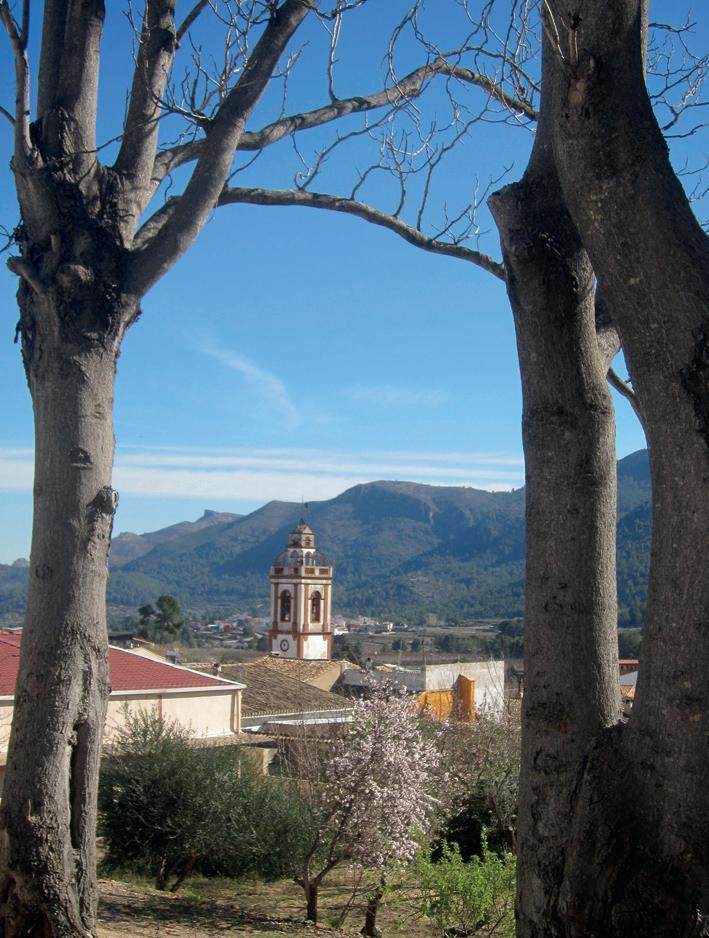
another small urban centre at the end of the region. Between Terrateig and Montitxelvo is located this Municipal Natural Area in a beautiful area of great ecological value. The general crossing continues to Aielo de Rugat, where we also have the possibility of accommodation in a country house known as the Riu Rau de Rafaelet, although it has to be booked in its entirety. It is a good place for groups, and in the village we also have a restaurant where you can eat or dine, specialised in grilled meats. All the populations through which we will pass until the end of the stage, respond to a common origin: Islamic farming that was repopulated with Christians after the reconquest. For the most part, the existing population of Muslim origin was able to stay there, as the monarch respected their customs and habits, but after the expulsion of the Moors four centuries later, these nuclei were left uninhabited. From Aielo de Rugat we will continue to Rugat by the Camí del Molí, to a place known as the Toll del Datiler. This path that takes height and then descends, allows us to reach the Mill of Rugat, where the wheat and corn were converted into flour. It milled grain all year round and was in operation until 1963. From the mill we will reach Rugat passing next to the Natura campsite, a rural tourism complex where campers spend the summers in a pleasant and cool environment, since this place is open to the north and influenced by the sea breezes. The campsite has bungalows where you can stay overnight too. We will cross the town of Rugat and reach Castelló de Rugat. In Rugat is Menjars Clareta, a restaurant that offers traditional food with a certain originality, gastronomic reference for years, located on the Camino Real. Originally it was a riu rau dedicated to the elaboration of the raisin that was subsequently exported mainly to England from the ports of Dénia and Gandía. Today there is little left of its original structure, but the place is nice and very cozy. To Castelló de Rugat we will arrive on the eastern part of the town, following agricultural roads and from Virgen del Remedio Street, we will pass through the very center of the town.
58 Stage 4_At the Benicadell’s shadow
Otos path.
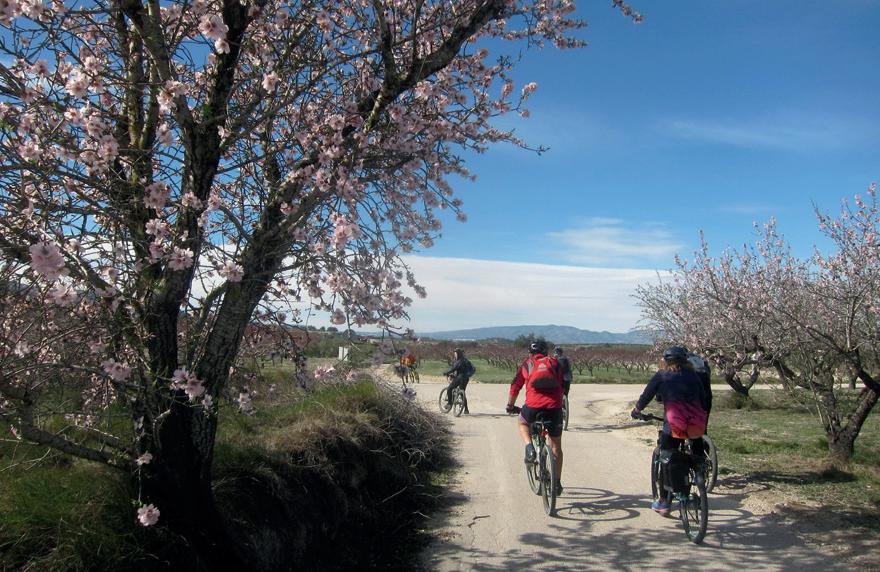
Castelló has a good set of bourgeois houses, emerged from the traditional ceramics-related industry, such as the manufacture of jugs to store oil, wine or water. There are excellent examples of these civil architectural constructions and some palaces such as the Alberola Palace and the Borja Palace, whose origin dates back to the fourteenth century and on which the Duke of Gandía would make a series of extensions. Very close to the palace are the remains of a mosque of the Islamic period, unique in the region and the few existing in the Valencian Community. Its origin would date back to the fifteenth century and would be used by Muslims who remained in the region until their expulsion.
Beniatjar is one of the starting points for the ascent of Benicadell on foot. The path of les Fontetes to the forest house of les Planisses is one of the classic ascents to access its summit
Escultura de Carrícola.
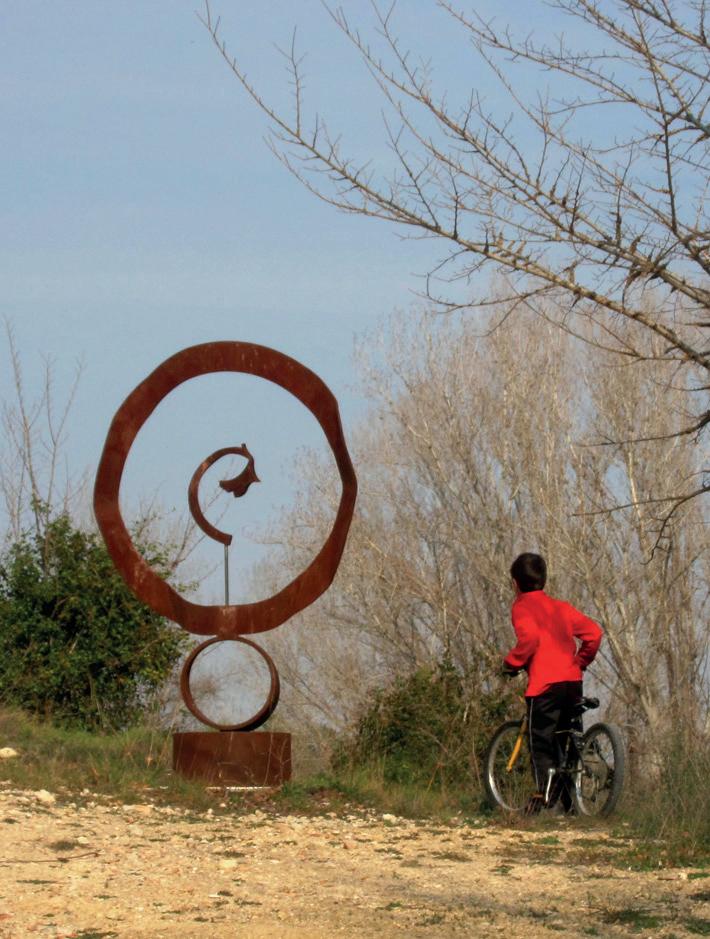
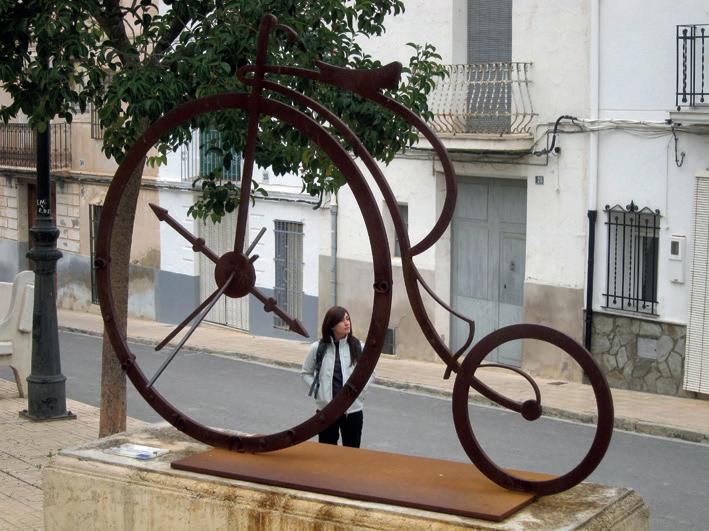
Otos.
Following the Camí Vell de Ràfol we will arrive to Ràfol de Salem, very close to Castelló to continue to Beniatjar, crossing one of the ravines that descend from the Benicadell, the Fuster’s ravine. Beniatjar is one of the starting points for the ascent of Benicadell on foot. The path of les Fontetes
59
to the forest house of les Planisses is one of the classic ascents to access its summit. Remember also that from Ràfol de Salem departs the thematic route of Umbría del Benicadell for those cyclists who prefer to make a variant of the crossing through the foothills of the Benicadell, following the forest track that reaches Atzeneta. This most demanding and mountaineering route offers a more aerial view of the Vall d’Albaida. From Beniatjar we will leave the road to follow Otos by the Camí Vell de Xativa, which, although asphalted, runs among the fields of traditional cultivation, olive trees, above all, and fruit trees. Otos is well worth a careful visit not for its urban area, but for the collection of sundials located throughout the village, either on the facades, either in some roundabout or as exempt monuments in some small garden. This initiative that defines Otos as the surprising and unique sunwatch village in Europe has attracted numerous tourists. The idea came from the mathematician Joan Olivares and the painter Rafa Amorós who managed to convince sculptors and painters of international prestige such as Andreu Alfaro, Rafael Armengol, Antoni Miró or Manuel Boix among others, to translate their works of art in the form of sundials in the streets of the population. There is a signposted route where you can see them, as a kind of game, in which the clocks are discovered one by one. There are also guided tours that allow to know the theme and intentionality of the artists. Otos has an excellent traditional food restaurant, Ca les Senyoretes, which also functions as a rural hotel and which, from the back of the house, allows you to see a beautiful
60 Stage 4_At the Benicadell’s shadow
picture of Benicadell from its terrace. From Otos we will follow the path that takes us to the Font de Baix, next to the channel of the ravine of la Mata, with a small raft and laundry, and by rural roads we will reach Carrícola, in a stretch of strong slopes that save the ravines that descend from the great mountain, some with permanent watercourse. The verticality of this area means that these ravines can be potentially dangerous in rainy season. Carrícola is a town that has a specific charm. Committed to the environment, everything in the municipality is intimately linked to ecology, heritage and art. More than sixty outdoor sculptures are scattered throughout the environment and following the marked trails you can walk up the mountain enjoying curious works of art integrated into the natural environment. It is worth noting the hydraulic heritage linked to the ancient ditches of Islamic origin that continue to function, and the arches of the Font del Gatell, the aqueduct of the Passeres ravine or that of the Arcada are already mentioned in historical documents of the fourteenth century. They continue to function to transport water from the fountains and rafts to the small orchards of the Carrícola and Bèlgida. The same hermitage of Calvary is built on a spring that was used by the Muslims to bring the water to the fountain of the square. The small mosque faced by the Benicadell was converted into a Christian church in 1572. Its whitewashed facade reminds us of its origin. Carrícola has a rural hotel and the possibility of renting to the town hall the old schools rehabilitated for groups. From Carrícola in rapid descent we will reach Bèlgida, and continue to El Palomar, a town that also has interesting accommodation possibilities, such as the Els Horts de Palomar Rural House in the vicinity of the town. From El Palomar by the Pla de les Cotes we will head towards Albaida, passing before the vicinity of the Mill of les Clotes and the mill of Porta, before reaching the Albaida river. One kilometer before arriving in Albaida we will also pass another interesting rural complex, El Pansat. Located in the middle of an agricultural farm where orange trees and all kinds of fruit trees are grown, it has the possibility of accommodation, even to spend a few days of tranquility, with friends or family. The city of Albaida, capital of the old Marquisate, and town that gives its name to the region, will be the end point of the fourth stage of our journey.
Download the route:
https://es.wikiloc.com/wikiloc/view.do?id=21207874
61
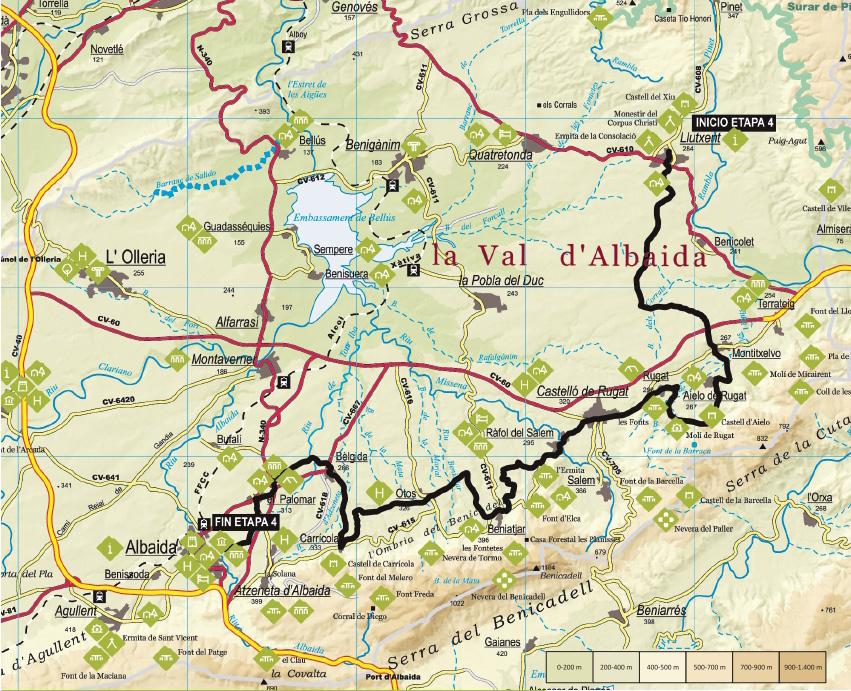
Stage 4: At the Benicadell’s shadow
Data sheet
39,22 km No
844 m 384 m
808 m 188 m
Orographic profile
384 m
188 m Roads and tracks: 36,22 km Highway: 3,00 km Physical difficulty: Moderate Technical difficulty: Easy Starting point: Llutxent End point: Albaida
62 Stage 4_At the Benicadell’s shadow. To make a stop
Rafaelet’s riu rau Castelló de Rugat Mosque

The sundials from Otos
Villa for groups
Built on an immense plot of more than 13000 meters, next to the last houses of Aielo de Rugat, surrounded by forest and at the foot of the last foothills of the Benicadell mountain range, is this magnificent villa that is rented in its entirety, with capacity for nine people, ideal for groups and that can be reserved for a single night. Nearby is Bar Aielo, in the street of the Church, where they prepare typical dishes, meat or grilled sausages.
Medieval evidence
Discovered in the basements of a house in the historic center in Palau Square, is one of the three mosques that have been preserved in the Valencian Community along with that of the Xara in Simat de Valldigna or that of Benaeça de Chelva. The enclosure consists of a rectangular prayer room with two naves and six vaults covered in brick with details of glazed ceramic ornamentation. It is located in the Palau’s Square inside a municipal building.
The art of shadows
The population of Otos has the best collection of sundials in Europe. They are spread over urban heritage and have been built and donated by renowned artists. You can take a guided tour or on your own, an interesting tour of the town and finish in the Palace of the Marquis de Sant Josep, where the outbuildings of the town hall and the permanent exhibition of paintings and sculptures by Antoni Miró are located.
casaruralrafaelet.com
Aielo de Rugat Carrer Projecte Número 7 T 696 918 333 - 679 048 466 casaruralrafaelet@gmail.com
turismecastelloderugat.com
Plaça de la Constitució, 7 46841 Castelló de Rugat T 96 288 30 10 info@turismecastelloderugat.com
otos.es
Ayuntamiento de Otos C/ Sant Josep, 6 46844 Otos T 96 235 82 35
63
Ca les Senyoretes
A balcony to Benicadell
Ca Les Senyoretes is one of the most important manor houses in Otos. It belonged to the landowner Celestino Alfonso, descendant of a local lineage that dates back to the repopulation of 1611, after the expulsion of the Moors. Converted into a hotel, it owes its name to its last inhabitants, Isabel and Teresa. The House retains some furniture from all eras in which it has been inhabited and has a living room, dining room with wood burning fireplace and its own restaurant where you can taste the best dishes of traditional Valencian cuisine.
ruralotos.com
Sant Crist, 1, 46844 Otos T 96 235 80 32 - 620 58 87 24 casa@ruralotos.com
Hostal Restaurant Carrícola
Hostel with art
Carrícola is one of the populations of the Benicadell mountain range, very committed to the environment and organic agriculture. It has only a hundred inhabitants and its charm lies in the mountain environment where it is located. The country hostel has 8 double rooms and its specialty is traditional Mediterranean cuisine, including all kinds of rice dishes where duck paella with tender garlic stands out. A good place also to stay overnight or eat during the crossing.
@hostalrestaurantcarricola
Carrer del Bot, 4 46869 Carrícola T 96 235 61 61 parartaula@gmail.com
Els Horts of El Palomar
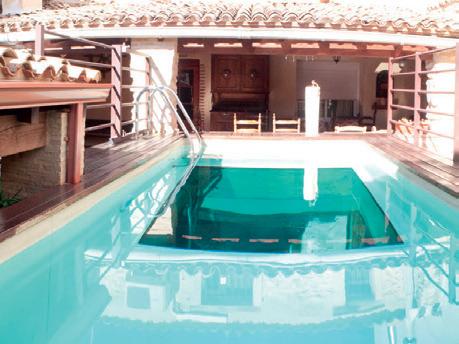
And the tradition of “El Xop”
Casa Rural El Palomar is located on the main street of the village of El Palomar, a small town of just 600 inhabitants, known for an ancient tradition “El Xop” where a large poplar is moved to the square and around it shepherds’ dances are carried out. The traditional house offers a relaxing, antique-laden stay with a spacious dining room and nine rooms. Perfect for groups and ideal to rest as it is very close to Albaida, almost at the end of the fourth stage.
casaruralpalomar.com
Carrer Major, 13 46891 El Palomar T 96 011 05 32 - 633 512 923









